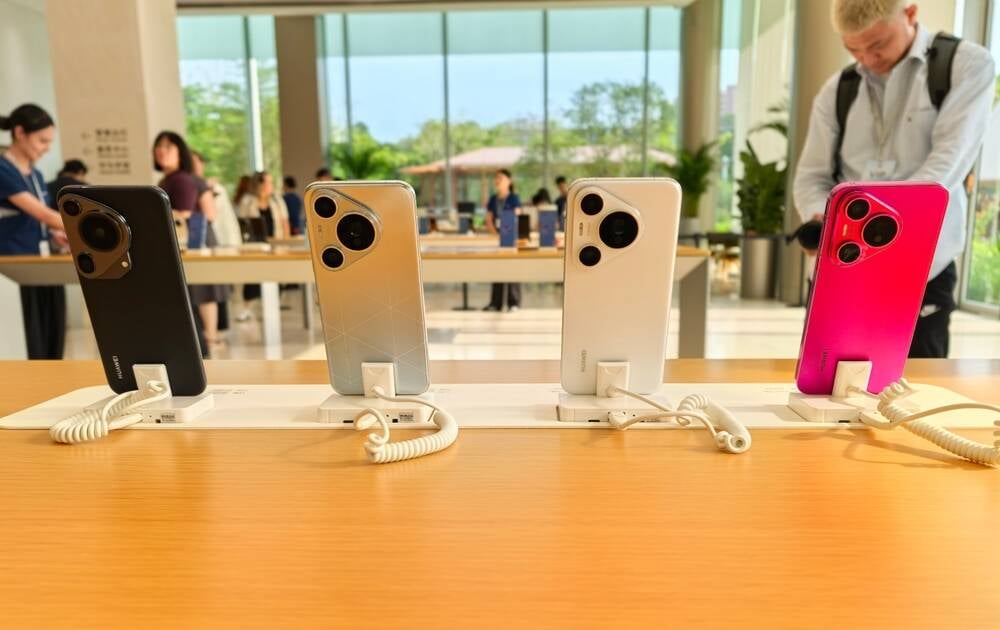


A teardown of Huawei’s Pura 70 Pro reveals that the China tech company’s latest smartphone is mostly made in China, with one notable exception.
Pura 70 smartphones on sale in Shenzhen Huawei store in April – Photo by: Shutterstock / Andrew Sozinov
The smartphone disection was conducted by repair tools company iFixit, which was able to obtain one of the China-exclusive phones with the help of Reuters. iFixit performed an in-depth teardown of the Pura 70 Pro, as well as conducting performance benchmarks to test the mettle of Huawei’s latest Kirin 9010 SoC.
It has been known since April that the Kirin 9010 is very similar to the older Kirin 9000S, both of which are produced by Huawei’s chip manufacturing partner SMIC on its 7nm node (also called N+2). However, reports from last month might have underestimated how similar the new Kirin is to the old one, as iFixit discovered that both chips have the same model ID. Even the revision names are almost identical: GFCV121 for the 9010, and GFCV120 for the 9000S.
iFixit theorizes that the 9010 is a refreshed 9000S with potentially higher yields (the percentage of good chips versus defective chips) and slightly higher performance. And when we say slightly, we do mean it, because the Kirin 9010 is only about eight percent faster than the 9000S in the popular Geekbench 6 performance benchmark.
The comparison is even less favorable compared to Qualcomm’s Snapdragon 8 Gen 3, which was roughly 45 percent faster than the Kirin 9010.
The teardown also confirmed that Huawei’s smartphone business is sourcing more parts locally. Most importantly, it’s using one of its own HiSilicon NAND chips with 1 TB of storage, something that’s not available in Europe. Analysis of the die implies that Huawei made the memory controller and packaged everything together, but that another Chinese manufacturer (perhaps YMTC) made the actual NAND storage.
However, neither the DRAM nor the motion sensors were made in China, with the former being produced by SK Hynix and the latter by Bosch. Huawei is likely just using up old parts, given that SK Hynix isn’t allowed to sell to Huawei due to sanctions, and also because both of these components can be made in China. Future Pura 70 Pro units may switch to domestic parts once existing stocks of foreign-made parts are used up.
Domestic production of components used for smartphones and other computers won’t be easy for Huawei, as the report points out. Though the company has proven that it has the technology to make at least the processor and storage on its own, being able to manufacture enough chips without spending too much money is the second step.
For more recent nodes, the usage of extreme ultraviolet (EUV) machines isn’t exactly necessary, but it does make it easier to achieve good yields. For example, Intel might have not had its woes with its 10nm node (now called Intel 7) if EUV lithography was widely available during its development in the 2010s. Instead, the company relied on standard deep ultraviolet (DUV) technology and sophisticated patterning, which initially resulted in poor yields.
The problem for Huawei is that Dutch company ASML makes all of the world’s EUV machines, which aren’t allowed to be shipped to China due to international sanctions. Huawei and its partners will have to rely on DUV for cutting-edge nodes, which probably poses difficulties for production. US Commerce Secretary Gina Raimondo claims this is exactly what Huawei is running into, saying 7nm-based Kirin chips can’t be made at scale.
Huawei is investing into making its own DUV and potentially EUV lithography tools, but it’s unclear whether its efforts will pay off. Should China’s semiconductor industry fail to make a breakthrough in production methods, the country might find itself incapable of making very many modern processors, even if companies like Huawei can design them. ®